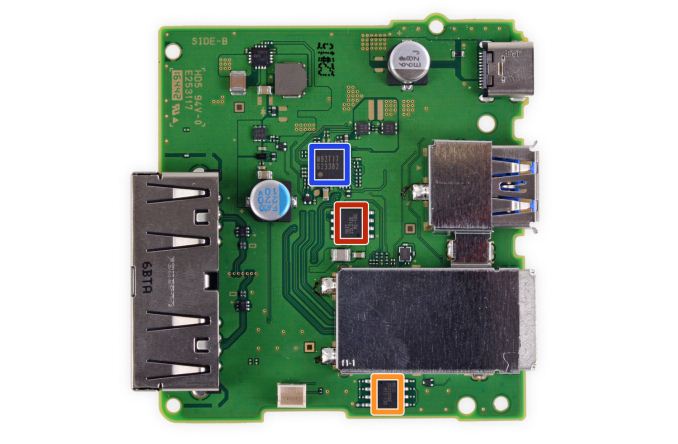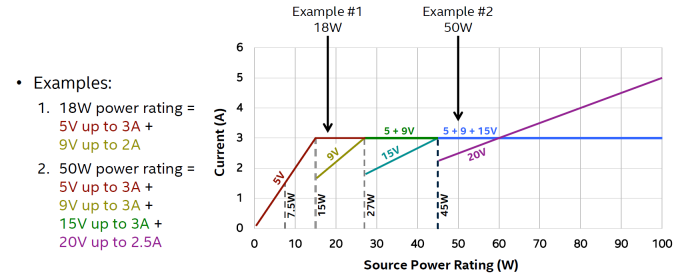Playing With Power: A Look At Nintendo Switch Power Consumption
by Ryan Smith on March 6, 2017 12:00 PM ESTGetting Nerdy: USB Power Delivery 2.0
Now to understand why this is, we need to talk a bit about the USB Power Delivery Specification 2.0, which is closely tied to USB-C. PD 2.0 establishes a series of voltages, depending on how many Watts a sink device needs. Furthermore it also defines the Amperage limits at each of these voltages (and in special cases when you can exceed them).
In short, PD 2.0 defines 4 voltages: 5V, 9V, 15V, and 20V (and a fully optional 12V mode). USB-C cables, in turn, must be able to carry 3 Amps. As a result, you end up with the following ranges.
After you reach 3A at a given voltage, if a device still needs more power it should switch up to the next voltage if it’s available and the device can accept it. The Switch’s own power adapter of course likes to run at 15V, and I’ve also confirmed that the console will take 9V and 5V.
For whatever reason, Nintendo seems to limit the Switch to pulling 2A, regardless of the voltage. There’s nothing wrong with this – it just is – but it does influence how well third party power adapters and power banks can power the Switch. Anything that can only deliver 5V, such as a power bank, low-end charger, or most laptops, will max out at 10W before cable losses. Again, this is sufficient to run the undocked Switch, it just means it can’t charge while it’s running.
The one downside here with respect to power banks is that, to the best of my knowledge, none of them support USB Power Delivery with 9V or better. Because only a handful of USB-C devices even take more than 5V, this is sufficient to charge phones, tablets, and even to slowly charge a MacBook. So until someone comes out with a power bank that supports USB-PD’s higher voltage modes, 10W appears to be as quickly as you can charge a Switch. Update: It turns out that RAVPower is shipping a rather sizable 99 Whr power bank that does support higher voltage modes, their 26800mAh USB Type-C pack. So if you need a pack that can play and charge the Switch at the same time, this should be able to do the trick. The one downside is that they don't currently offer a multi-voltage power bank in any other capacities.
USB Type-C Cables: 2.0 versus 3.0/3.1
On a quick aside, I’ve seen a few questions about what kind of USB Type-C cable is needed to connect the Switch to a power bank or third party charger, whether it needs to be a “2.0” cable or a “3.1” cable. The good news is that as long as the cable is built to specification, any cable will work.
The USB specification requires that all standard/passive USB-C cables be able to carry at least 3A, regardless of their data speed. So for charging purposes, a good cable is a good cable. And this goes for 9V/15V/20V chargers as well.
In fact the only reason there are even different cables is due to a combination of cost optimizations and a desire to allow thinner, more flexible cables. USB SuperSpeed (3.0) and SuperSpeed+ (3.1 Gen 2) signaling requires a relatively thick cable to properly conduct the signal and shield the high speed lanes. USB 2.0 on the other hand is a much simpler and slower signaling standard, which in a USB-C cable uses a different set of wires altogether. As a result a USB-C 2.0 cable can forgot the high speed lanes, making it a lot thinner. Just bear in mind that as handy as a thin USB-C 2.0 cable is, you will need a USB-C 3.0/3.1 cable if you want to get those data rates between devices.
Yes, You Can Use Third Party Power Adapters
As for third party power adapters, those will easily work with the Switch. As long as they support USB Power Delivery you should be good to go. I’ve tested the Switch with the adapters I have on hand – which all happen to be Apple adapters – and it works exactly as you’d expect. However keep in mind that you’ll want at least a 15V adapter if you want to match Nintendo’s stock power adapter's capabilities.
| Switch Power Consumption: Third Party Power Sources | ||||
| Charging (Sleep) | ||||
| Apple 87W USB-C Adapter | 9.6W (8.88V @ 1.08A) |
|||
| Apple MacBook Pro 15" (2016) | 7.1W (4.8V @ 1.47A) |
|||
Also, it should be noted that a larger adapter will not charge the Switch any faster, even at 15V. The tablet itself can charge at a peak rate of 10W, and no faster. The Nintendo adapter can give the Switch all it can handle, so the only purpose of additional adapters are for portability and better charging rates with other, higher-power devices.
But No, You Can’t Use Third Party HDMI Adapters
Finally, while I wasn’t expecting this to work in the first place, I also tried the Switch with third party HDMI adapters. As a quick refresher, the Switch natively outputs DisplayPort over its USB-C port, which is then converted to HDMI inside the dock. So, on paper, any adapter similar to the Dock should work with the Switch.

The Switch Dock's PCB (Image Courtesy iFixit)
However it would seem that Nintendo isn’t going to allow this. Attempting to use Apple’s Digital AV Adapter – which for all practical purposes is as close to the Switch Dock in functionality as you’re going to find – was rebuffed by the Switch. The Switch wouldn’t even charge with Apple’s adapter in the chain, let alone output HDMI. And no other adapter had any more luck. So if you want to get HDMI out of your Switch, then you’re going to need to use Nintendo’s official Dock (at least until they start approving third party docks).
Finally, a quick shout-out to Patrick for the best article title submission: "The Old Switch-eroo: How to charge Nintendo's newest console"











61 Comments
View All Comments
OCedHrt - Monday, March 6, 2017 - link
Doesn't quick charge power banks also provide more than 5V?Ryan Smith - Monday, March 6, 2017 - link
Quick Charge is a proprietary standard not supported by the Switch.psikick - Tuesday, March 7, 2017 - link
Just sharing that Nathan K. (who has been doing analyses of various USB-C peripherals now) found a few flaws with the power bank (although he does note that it works, there are just quirks). However, he advises to avoid using the charger that comes with the power bank as it is potentially dangerous (says they should be recalled).https://plus.google.com/102612254593917101378/post...
and
https://plus.google.com/102612254593917101378/post...
jhoff80 - Monday, March 6, 2017 - link
FYI, the Switch also supports the (now optional in USB-PD 2.0) 12V profile.But also, I would recommend a lot of caution with the Satechi meter. The build quality on it is terrible - so terrible in fact that the plastic trim on the inside of the USB-C port on mine broke off inside my Switch.
Ryan Smith - Monday, March 6, 2017 - link
Thanks. I don't have any 12V devices around, but it's good to know.As for the Satechi, yeah, it's not the greatest in terms of build quality. Though I haven't had anything close to what you've described happen, thankfully.
jhoff80 - Monday, March 6, 2017 - link
Yeah, luckily I was able to use a tiny pair of tweezers to get the plastic out of the USB-C port without damaging the center board in the female USB-C connector, but it was definitely making me curse the fact that USB-C doesn't use a lightning style design with the board on the cable.Schmov17 - Monday, March 6, 2017 - link
Ryan, I would try testing the Switch with a non-Apple USB-C>Video adapter. From my experiences with the Apple adapters, I believe that they have some kind of built in authentication feature that can tell when it is connected to an Apple device, and does not function when connected to a non-authorized (non-Apple) device.jhoff80 - Monday, March 6, 2017 - link
I've tested with a Huawei MateBook 'MateDock' (2 USB, HDMI, VGA, Ethernet, and PD passthrough), the Aukey USB-C dock (3 USB, HDMI, and PD passthrough), and an LG 27UD88 (USB-C monitor). The Switch only works with the Switch's own dock. Presumably it's using USB-C's vendor-specific signaling or something of that sort.Schmov17 - Monday, March 6, 2017 - link
Good to note, thanksphoenix_rizzen - Monday, March 6, 2017 - link
From the article:"In short, PD 2.0 defines 5 voltages: 5V, 9V, 15V, and 20V."
That's only 4 voltages. What's the fifth?